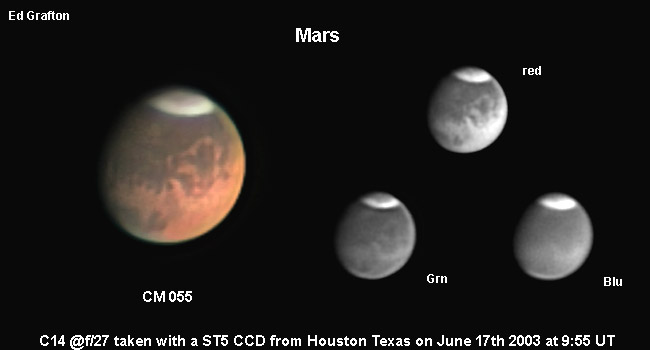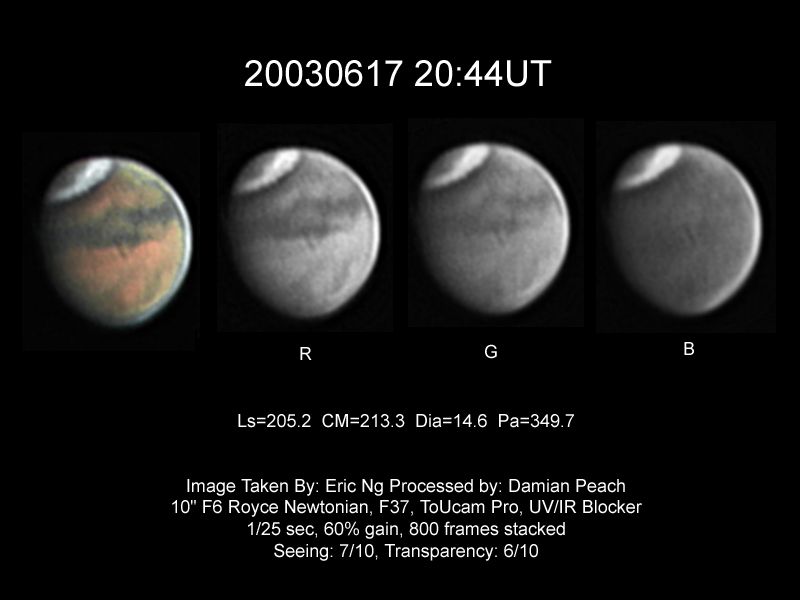火星 月惑星研究会 関西支部 (最新)
ALPO-Japan Latest
Mars Image 2003/06/17(UT)
Ed Grafton,Eric Ng,David M Moore
E.Grafton,Eric,D.Moore
解説(安達)
今回も日本の天候は悪く、日本の観測は集まりませんでした。ブラフトン氏
(Ed Grafton)からは詳細な様子が報告されてきました。南極冠の内部は、全体
の画像の写り方から考えると、線状ではなく、むしろゆったりとした暗さの変化
を示す様です。線状の割れ目のような模様ではないことがうかがわれます。
20W付近の輝点は周辺減光の中でもはっきりと確認できます。ブルーの画像か
らはアキダリウム(Mare Acidarium;30W,+50)付近に霧か白い雲の赤っている様子
がとく捉えられています。エリック氏(Eric Ng)の画像は細部まで非常によく出
ており、時にキンメリウム(Mare Cimmerium;220W,-20)の中央から北にのびる2
つの暗柱が鮮明に出ています。このように鮮明に記録されたのは今シーズン初だ
と思われます。ヘスペリア(Hesperia;240W,-20)は今まで比較的暗く写っていま
したが、この画像からは筋状の明瞭な輪郭がすっかり失わrてしまった様子が分
かります。2001年の大黄雲の影響でしょう。エリダニア(Eridania;215W,
-45)は2001年には非常に明るくなっていましたが、今年はあまり明るくあり
ません。いままでは暗く観測されてきましたが。これから南極冠が縮小してくる
と明るくなるかも知れません。注意しなければなりません。ムーア氏
(DavidM.moore)の画像では低緯度地方の氷晶雲が良く出ています。アルギレ
(Argyre;30W,-50)付近の白い3本の筋はたまたまこの付近の明るい部分がこの
方向に並んでいたためにできたものと思われますが、いずれもほとんどが同じ
方向になっていることが気になります。また、ム?ア氏のブル?ではタルシ
ス(Tharsis;95W,+10)にある3つの火山にかかる雲が鮮明に出ており、しかも
午前中に見えることから、大気の水蒸気が増加していることがわかります。
(repoirted by 3 observers)
June 17th, 2003
This time, too, Japan had inclement weather and the observation didn't
center. Ed Grafton reported a detailed observation record.The inside of
SPC is not a crack having to do with a line and seems to express the
change of the big light. 20 W of the light part which is inside SPC
are being most cleared. The coming state of white cloud is recorded
about whether or not it is fog near Acidarium (30W,+50)in the blue image.
The image of Erich Ng is well shown to the detail. Specifically, it
very well understands projection which stretches north from the center of
Cimmerium(220W,-20). It is in this season beginning that this
appearance will be clearly recorded. Hesperia(240W,-20) became dark
and at so far the cleared crack, it ran out. This will be the influence
of the major dust storm in 2001. Eridania(215W,-45) became not bright.
In the image of David M.Moore, water ice cloud in the place with low
latitude can be well seen. That three white bands near Argyre(30W,-50),
stand in line in the same direction is interesting. In the blue of
Moore, the cloud which hangs over three mountains of Tharsis(95W,+10)
is well deteriorated. It finds that a lot of steam is contained in the
atmosphere from this thing.
FROM Makoto ADACHI
-------------------------------------------------------------------------------------
|
Ed Grafton (14 inch f/11 Celestron SCT, ST6 CCD medium resolution mode)
|
|
Hi Mars Observers
Here is an image from June 17th 2003 at 09:55 UT taken from Houston, Texas.
The sky transparency was very good, 8/10 and seeing was very good, 8/10. The
temperature was in the mid 70s F with heavy dew present.
 RED + IR rejection, .15 seconds, SBIG filter
GREEN + IR rejection, .3 seconds, SBIG filter
BLUE + IR rejection, .5 seconds, SBIG filter
Luminance, RED filter + IR, 600-1000nm .05 seconds
Edmunds filter
[Ed Grafton, Houston Texas U.S.A.]
RED + IR rejection, .15 seconds, SBIG filter
GREEN + IR rejection, .3 seconds, SBIG filter
BLUE + IR rejection, .5 seconds, SBIG filter
Luminance, RED filter + IR, 600-1000nm .05 seconds
Edmunds filter
[Ed Grafton, Houston Texas U.S.A.]
|
Eric Ng (10" F6 Newtonian homebuilt reflector : ToUcam Pro)
|
|
Dear friends
Finally the sky was clear last night until this morning.
Not only the seeing was good, the transparency improved a lot too!!! (compare with the one taken on 4 June).
This time I used the Baader UV/IR Blocker instead of TrueTechnology one.
The transmission of the visible wavelength is 98%.
 As I was quite rush to back to office this morning. After selected and stacked the avi, I was lucky to see Damian
is online in my ICQ list. He is so kind to process the composite raw I sent to him. Such joint effort is really great
both of us appreciate it very much.
As Wei Leong pointed out toucam + IR blocker, the results is no obvious difference with the restricted bandpass
400-500nm and 600-700nm by using magenta filter.
Therefore, I preliminary stacked the one without magenta filter in this morning.
I shall process another one with magenta filter with RR(G)B or
R(G)B and see the results.
It seems there are some yellowish (dust?) clouds above the Hellas at the AM limb.
Please kindly comment on it.
[Eric Ng, Tai Po site Hong Kong, China]
As I was quite rush to back to office this morning. After selected and stacked the avi, I was lucky to see Damian
is online in my ICQ list. He is so kind to process the composite raw I sent to him. Such joint effort is really great
both of us appreciate it very much.
As Wei Leong pointed out toucam + IR blocker, the results is no obvious difference with the restricted bandpass
400-500nm and 600-700nm by using magenta filter.
Therefore, I preliminary stacked the one without magenta filter in this morning.
I shall process another one with magenta filter with RR(G)B or
R(G)B and see the results.
It seems there are some yellowish (dust?) clouds above the Hellas at the AM limb.
Please kindly comment on it.
[Eric Ng, Tai Po site Hong Kong, China]
|
David M. Moore(25cm Newtonian, Philips ToUcam)
|
|
 [ David M Moore Phoenix, Arizona U.S.A]
[ David M Moore Phoenix, Arizona U.S.A]
 ALPO-Japan Latest
ALPO-Japan Latest

 Mars Section
Mars Section
 RED + IR rejection, .15 seconds, SBIG filter
GREEN + IR rejection, .3 seconds, SBIG filter
BLUE + IR rejection, .5 seconds, SBIG filter
Luminance, RED filter + IR, 600-1000nm .05 seconds
Edmunds filter
[Ed Grafton, Houston Texas U.S.A.]
RED + IR rejection, .15 seconds, SBIG filter
GREEN + IR rejection, .3 seconds, SBIG filter
BLUE + IR rejection, .5 seconds, SBIG filter
Luminance, RED filter + IR, 600-1000nm .05 seconds
Edmunds filter
[Ed Grafton, Houston Texas U.S.A.]RED + IR rejection, .15 seconds, SBIG filter GREEN + IR rejection, .3 seconds, SBIG filter BLUE + IR rejection, .5 seconds, SBIG filter Luminance, RED filter + IR, 600-1000nm .05 seconds Edmunds filter [Ed Grafton, Houston Texas U.S.A.]
As I was quite rush to back to office this morning. After selected and stacked the avi, I was lucky to see Damian is online in my ICQ list. He is so kind to process the composite raw I sent to him. Such joint effort is really great both of us appreciate it very much. As Wei Leong pointed out toucam + IR blocker, the results is no obvious difference with the restricted bandpass 400-500nm and 600-700nm by using magenta filter. Therefore, I preliminary stacked the one without magenta filter in this morning. I shall process another one with magenta filter with RR(G)B or R(G)B and see the results. It seems there are some yellowish (dust?) clouds above the Hellas at the AM limb. Please kindly comment on it. [Eric Ng, Tai Po site Hong Kong, China]
[ David M Moore Phoenix, Arizona U.S.A]
 ALPO-Japan Latest
ALPO-Japan Latest

 Mars Section
Mars Section